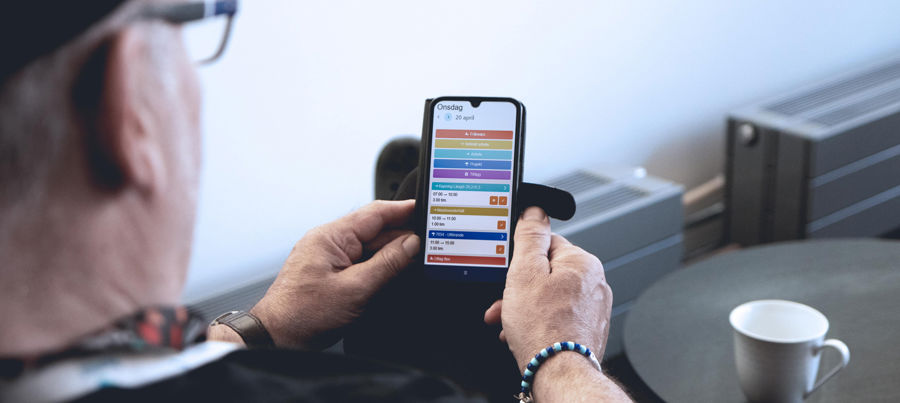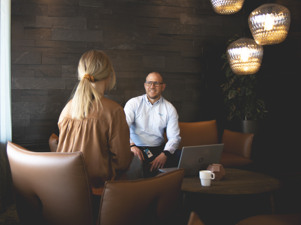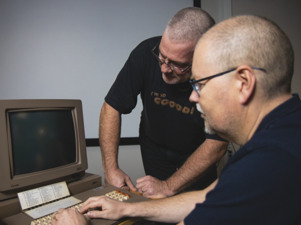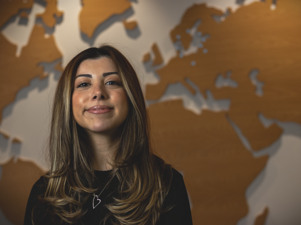Big project provided invaluable experience “I learned so much more.”
Fresh from higher education and after just a few months of employment with the company, Martin Karlsson and Rasmus Lindberg were given a big opportunity with the chance to manage a major new project – Monitor need a new app to record time and work retroactively.
Development of the TimeCard product began back in autumn 2021, and in early 2022, junior developers Martin Karlsson and Rasmus Lindberg were given the chance to take over the project under the supervision of product owner Partik Sundin, who has worked at Monitor for several years.
Can you tell us about the background to the new TimeCard product?
“It’s aimed mainly at mobile fitters and installers. It’s a web-based app you can use on any device. We had a similar optional product in the previous version of the ERP system (Monitor G4), but this was built for Microsoft Silverlight, and when modern browsers stopped supporting the system we didn’t have a solution to offer,” Patrik explains.
The success of the project meant collaborating with different departments within the company. And since TimeCard incorporates functionality from a specific area of Monitor – the Time recording module – it was important to have close communication with the development team responsible for this module.
“There were a lot of people involved. We got a lot of help from Jonas Lindgren in G5 Development, who is an expert on the Time recording module, as well as the Documentation team, who quickly delivered phrases and translation.”
TimeCard has been a major project. Patrik estimates that it took somewhere between 1,500 and 2,000 hours to complete. He was involved with testing, and they also used a number of customers to provide feedback as development of the app took place.
“We performed a lot of demos with customers where we showed the development environment and explained what can and can't be done. We noticed that it suited many, while others started to review how they actually work, and we received lots of good feedback and useful suggestions on functions direct from customers,” says Patrik.
Many aspects of the project were new for the developers, Martin and Rasmus. They normally work on development of another Monitor option, the Webshop. Now they were asked to learn a new part of Monitor, as well as new technologies.
“Most of it was new in relation to our studies,” said Martin. “We used a lot of new technologies – Angular, Dapper, .Net 6 – that we hadn’t used before.”
What was most fun about the project?
Martin: “To embrace things a little more. When working on the Webshop it felt like were a small part of a much larger project, but here we could draw up the whole thing ourselves. It’s easier to work when you’re familiar with everything.”
Rasmus: “I agree. Having responsibility for the project in this way was really fun.
Patrik: The best thing was to start from scratch and take it all the way to a finished product. To ensure everything ultimately falls into place, and nothing is forgotten, so we have everything from translation and manual to support for the finished product. And working on a limited, short-term project is really enjoyable.
I've learned so much more, and in a better way, after working here compared to when I was studying.”
Rasmus focused on what was “under the hood”, on the server side, while Martin had the biggest responsibility for building the UX part of the product alongside designer Marcus Losbjer.
“He designed everything, and I tried to construct the app based on his blueprint. It’s great to feel like you have a bigger influence on a project in this way,” Martin say.
Before starting at Monitor, Martin studied web development for two years. Rasmus had a LIA (Learning in Work) placement and a summer position at Monitor before being employed in the Adaptation department in 2021.
“I've learned so much more, and in a better way, after working here compared to when I was studying” Martin says.
The small development team works on agile lines in three-week sprints, with stand-up meetings every morning to review what’s in the pipeline. In addition, developers spend time in the Support department on a regular basis in order to meet customers, that is, those that actually used the system.
“I think this is really important to make sure you don’t end up in your own little world,” Patrik says.
He underlines the importance of carrying out a thorough pre-study ahead of this type of project. You need to know the potential risks and the resources required to deliver on schedule.
“It's important to do things property, and not rush things and make mistakes. The app should be durable and work over time. This is really nothing unique, but simple common sense. We could always have put something together quickly for faster financial gain. But that’s not how we work at Monitor. We think in the long term.”
At the time of writing the team have just completed the most important stage: a live demo of the product for 500 customers at Monitor’s user seminar. And it all went to plan.
The plan is to begin selling and delivering TimeCard to users in early July. And that will bring the project to a close. But the team all agree that this is the best part. That is, working on a clearly delineated project close to the product as well as the end users.
They’re now getting ready for the next project which involves ... that’s a secret for now!





